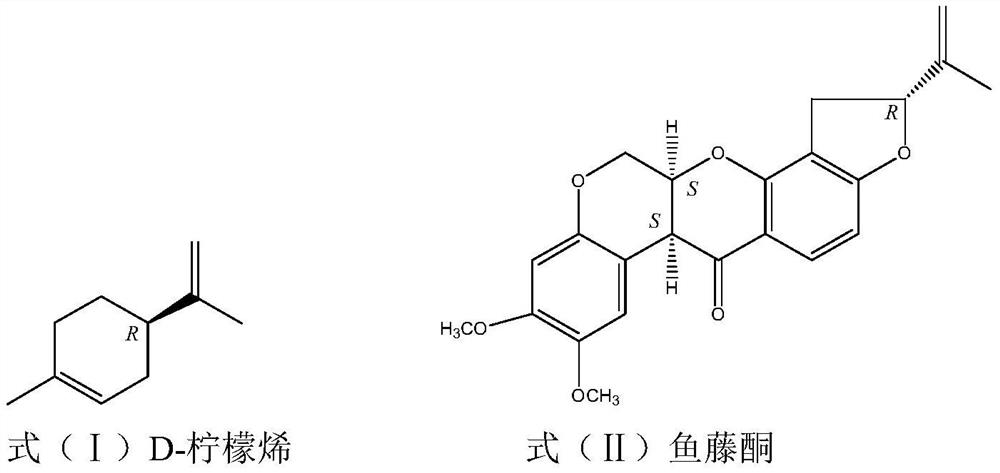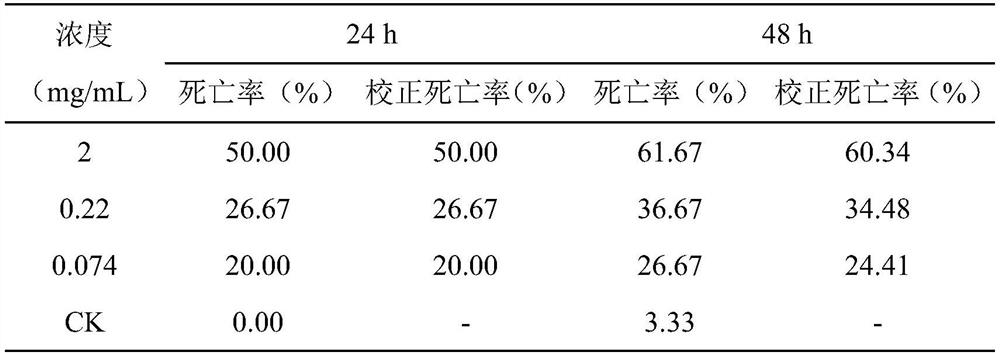Acaricidal composition of d-limonene and rotenone and its application
A composition and a technology of limonene, applied in the field of pesticides, can solve the problems of decreased and aggravated effects of acaricides, and achieve the effects of difficult generation of resistance, simple preparation process and obvious poisoning activity
- Summary
- Abstract
- Description
- Claims
- Application Information
AI Technical Summary
Problems solved by technology
Method used
Image
Examples
Embodiment 1
[0025] The contact activity of embodiment 1D-limonene to Panonychus citrus
[0026] The slide dipping method recommended by FAO was used. Stick the double-sided adhesive on the glass slide, pick a healthy and lively adult female mite of the same size with a zero brush, gently stick its back on the double-sided adhesive, put the glued glass slide on the tray, Place in RXZ incubator (28±1°C, 65±5% RH, 16:8(L:D)). After 4 hours, observe under the microscope, remove the dead and inactive mites, record the number of live mites, and then put the slide in the petri dish containing the medicine for 5 seconds, gently absorb the medicine around the mites with paper, and wait until completely After drying, place in the incubator. Each concentration was treated with 3 replicates. Observe and record the number of deaths for 24 hours (touch lightly with a brush during observation, and the body does not move as death), and the specific results are shown in Table 1.
[0027] Table 1 Deter...
Embodiment 2
[0030] Example 2 Activity of D-limonene on nymphs of Panonychus citrus
[0031] The toxic activity of D-limonene on nymphs of Panonychus citrus was determined by spray method, and the specific results are shown in Table 2.
[0032] Table 2 Determination of the contact activity of D-limonene on nymphs of Panonychus citrus (spray method)
[0033]
[0034] The results in Table 2 show that D-limonene also has poisonous activity against nymphs of Panonychus citrus.
Embodiment 3
[0035] Example 3 Oviposition Inhibitory Effect of D-limonene on Panonychus citrus
[0036] Cut flat cowpea leaves with a diameter of 5 cm, with the back facing up, spread them flat on the filter paper in a 9 cm plastic petri dish, add a circle of cotton strips around the leaves and humidify. Use a brush to pick up the female adult mites in the oviposition period and transfer them to the leaves. Insert 20 female adult mites on each leaf. Spray the medicine evenly on the leaves in the petri dish with a hand-held sprayer until the slope does not form a water flow. , each agent treated 3 leaves. Cover the petri dish after the treated leaves are naturally dried, and place them in an RXZ incubator (28±1°C, RH 65±5%, 16:8 (L:D)) for cultivation. Investigate the spawning amount in 24h, and calculate the results according to the spawning inhibition rate (%)=(control spawning amount-treatment spawning amount) / control spawning amount×100, see Table 3.
[0037] Table 3 Oviposition inhib...
PUM
 Login to View More
Login to View More Abstract
Description
Claims
Application Information
 Login to View More
Login to View More - R&D
- Intellectual Property
- Life Sciences
- Materials
- Tech Scout
- Unparalleled Data Quality
- Higher Quality Content
- 60% Fewer Hallucinations
Browse by: Latest US Patents, China's latest patents, Technical Efficacy Thesaurus, Application Domain, Technology Topic, Popular Technical Reports.
© 2025 PatSnap. All rights reserved.Legal|Privacy policy|Modern Slavery Act Transparency Statement|Sitemap|About US| Contact US: help@patsnap.com



